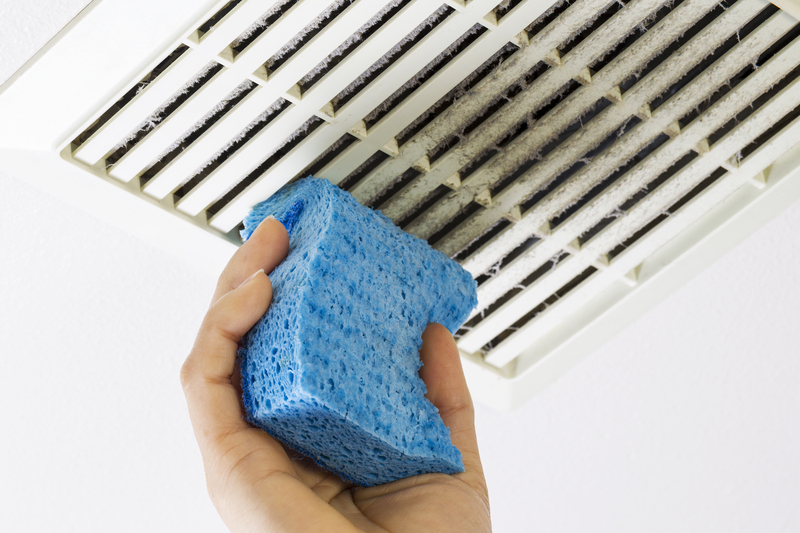Unlock the Key to a Clean Stovetop: Banish Burn Marks
Posted on 30/09/2025
Unlock the Key to a Clean Stovetop: Banish Burn Marks
Every home chef knows the frustration of trying to keep their stovetop looking spotless. With every delicious meal comes the occasional spill, splatter, and, unfortunately, burn marks that make your kitchen appliance look well-loved yet well-worn. But what if you could unlock the key to a clean stovetop and banish those pesky burn marks for good? In this comprehensive, reader-friendly guide, we'll walk you through everything you need to know about dazzling your stovetop, including top cleaning methods, helpful tips, and preventative measures to maintain a stain-free cooking surface.
Why Burn Marks Appear on Your Stovetop
Before you can effectively banish burn marks from your stovetop, it's important to understand what causes them. Burn marks, also known as scorch marks or stains, often occur due to:
- Boil-overs: When liquids overflow and are heated to high temperatures.
- Spills: Food residue that lands on hot burners and gets charred.
- High Heat Settings: Excessive heat can burn both food and cleaning agents if left unattended.
- Delayed Cleaning: Allowing spills to sit and dry typically makes burn marks tougher to remove.
Understanding these causes is the first step in developing effective strategies to clean your stovetop and prevent future build-up.

Types of Stovetops and Their Cleaning Needs
Stovetops vary in design and material, which means different approaches are required to remove stovetop burn stains. Here's a quick rundown:
Gas Stovetops
- Feature removable grates over burners.
- Burn marks and scorch stains often occur on the grates and drip pans.
Electric Coil Stovetops
- Coil burners sit above removable drip pans.
- Burn residue tends to bake onto pans and around coils.
Glass/Ceramic Stovetops
- Sleek and flat surfaces but can show every stain and mark.
- Prone to stubborn burn rings and discoloration.
Induction Cooktops
- Smooth like glass stoves, but use electromagnetic fields.
- Foods can still scorch and leave marks if they boil over.
Pro Tip: Always confirm your cleaning method is compatible with your stovetop type to avoid accidental scratching or damage.
General Steps for Cleaning Stovetop Burn Marks
Let's dive into the practical steps you can follow to banish burn marks from stovetop surfaces, no matter their material.
Step 1: Allow the Stovetop to Cool
Safety first! Never attempt to clean a hot stovetop. Wait until the surface has completely cooled down before beginning.
Step 2: Remove Loose Debris
- Wipe away crumbs or loose food particles using a soft, damp cloth or paper towel.
- For gas or electric coil stovetops, carefully lift off grates and drip pans.
Step 3: Create Your Cleaning Solution
For most stovetops, a simple solution of warm water and dish soap is effective for daily cleaning. For tougher burn stains, consider:
- Baking Soda and Vinegar Paste: Mix baking soda with a few drops of water to make a paste. Apply to burn marks, let sit, then spray with vinegar.
- Commercial Cooktop Cleaners: Ideal for glass and ceramic surfaces. Always follow manufacturer instructions.
- Lemon Juice: Its natural acidity breaks down stains and leaves a fresh scent.
Step 4: Attack the Burn Marks
Apply your chosen cleaning solution directly onto the burn mark. For stubborn stains:
- Let the paste or solution sit for 15-30 minutes to penetrate and break down the residue.
- Use a non-abrasive sponge or soft cloth to gently scrub the area in circular motions.
- For glass surfaces, use a razor blade scraper at a 45-degree angle (only if manufacturer-approved).
Step 5: Rinse and Buff Dry
Wipe away any remaining cleaner with a clean, damp cloth. Dry with a microfiber towel to avoid streaks.
Removing Stubborn Burn Marks from Stovetops
If you're dealing with particularly stubborn or old stovetop burn marks, try these advanced methods:
For Gas and Electric Coil Stovetops
- Soak grates and drip pans in hot, soapy water for 30-60 minutes.
- Scrub with a paste of baking soda and water.
- For extra-tough stains, sprinkle with a little kosher salt as a gentle abrasive.
- Rinse and dry thoroughly before reassembly.
For Glass and Ceramic Cooktops
- Apply a cooktop cleaner or a paste of baking soda and water.
- Gently use a cooktop scraper (if safe) to lift off the burnt residue.
- Buff with a clean, damp microfiber cloth for a streak-free shine.
For Induction Cooktops
- Never use harsh or abrasive cleaning pads.
- Opt for a soft cloth and specialized cleaner designed for induction or ceramic glass surfaces.
- For persistent stains, reapply the cleaner and let it sit before wiping away.
Persistence is key! Sometimes, repeated applications are necessary to fully erase burn stains on stovetops.
Eco-Friendly and Natural Cleaning Alternatives
You don't always need a cabinet full of commercial products to clean stovetop burn marks effectively. Try these green alternatives:
- White Vinegar: Cuts through grease and dissolves mineral deposits. Apply directly to stains, let sit, and wipe clean.
- Lemon Juice: Its acidity helps break down burnt food stains and leaves a pleasant fragrance.
- Baking Soda: A natural abrasive that is safe for most stovetop finishes.
- Hydrogen Peroxide: Effective on especially tough scorch marks. Mix with baking soda to form a fizzing cleaner.
- Salt and Water: A gentle, natural scrub that cuts through residue without scratching glass.
Always test natural cleaners on a small, discreet area first to ensure compatibility with your stovetop.
Daily and Weekly Maintenance Tips for a Sparkling Stovetop
Regular upkeep is the secret to maintaining that "just-cleaned" look and banishing burn marks from your stove before they set in.
Daily Maintenance
- Wipe spills and splatters promptly with a damp cloth.
- Avoid abrasive sponges--opt for microfiber or soft cellulose for everyday cleaning.
- After cooking, once cool, do a quick all-over swipe with a gentle soapy solution.
Weekly Maintenance
- Remove burner grates and soak in warm, soapy water.
- Deep-clean burner caps and drip pans with baking soda paste.
- Inspect for any stubborn stains or residue and treat as needed.
Preventing Burn Marks: Proactive Measures
Prevention is the easiest way to keep your stovetop clean and free of burn marks. Consider these proactive strategies:
- Use Splatter Guards: Especially helpful for frying or cooking fatty foods.
- Opt for Flat-Bottomed Cookware: Ensures even heating and minimizes scorching.
- Monitor Boiling Pots: Don't leave boiling liquids unattended--keep an eye out for boil-overs.
- Clean as You Go: Wipe up spills right away to keep your stovetop spotless.
- Use Appropriate Heat Levels: Cooking on low or medium heat can prevent charring food on the cooktop.
Products and Tools to Keep Your Stovetop Shining
The right tools can make all the difference as you banish burn marks and clean your stovetop effectively. Consider keeping these essentials on hand:
- Non-Scratch Sponges: Avoids damage while scrubbing stuck-on residue.
- Microfiber Cloths: Leaves no lint and buffs to a streak-free shine.
- Cooktop Scrapers: Try those designed for glass/ceramic surfaces for built-up burns (check manufacturer approval).
- Degreasing Spray/Cooktop Cleaner: For the occasional deep clean.
- Baking Soda and Vinegar: The classic duo for natural cleaning and deodorizing.
Common Mistakes to Avoid When Cleaning Your Stovetop
In your quest to banish burn stains from your stovetop, avoid these common pitfalls:
- Using Steel Wool or Abrasive Pads: These can scratch and dull your stove's finish, especially glass/ceramic models.
- Applying Too Much Water: Excess liquid can seep into appliance parts and cause malfunctions, particularly in electric stoves.
- Neglecting Regular Cleaning: Allowing stains and spills to build up makes them exponentially harder to remove.
- Skipping the Rinse: Leaving cleaning residues behind can cause streaking or even create more stains when heated.
When to Call a Professional
In most cases, persistent effort and the proper products can remove even the worst stovetop burn marks. However, if you encounter:
- Discoloration that seems to penetrate the material (especially on glass or enamel surfaces).
- Burn marks around electrical elements or gas components that may affect performance.
- Extensive corrosion or structural damage.
It's wise to contact an appliance professional. They can assess and repair possible underlying damage safely and efficiently.

Frequently Asked Questions (FAQ)
What is the best way to clean glass stovetop burn marks?
Use a specialized glass cooktop cleaner and a razor blade scraper, or create a paste from baking soda and water. Never use steel wool or abrasive pads.
How can I prevent stubborn burn marks in the future?
Clean up spills immediately, use the appropriate heat settings, and consider using splatter guards and flat-bottomed cookware for even heating.
Are there any safe home remedies for cleaning stove burn marks?
Yes, baking soda, vinegar, lemon juice, and salt can all be used for natural cleaning that's safe for most stovetop types.
Is it possible to remove burn marks from enamel cooktops?
Yes, in most cases. Use a baking soda paste and a soft cloth. Avoid abrasive pads, which can damage the enamel finish.
Conclusion: Enjoy a Spotless, Burn-Free Stovetop
With the right approach, you can banish burn marks from your stovetop and restore its shine, making your kitchen a more inviting place to cook and gather. Whether you favor natural cleaning methods or specialized products, the ultimate secret is consistency: a little attention after each meal goes a long way.
Remember, unlocking the key to a clean stovetop isn't about striving for unattainable perfection--it's about developing easy habits and using smart techniques to keep your cooktop in top condition for every meal.
Ready to reclaim your kitchen's gleam? Start today by putting these practical stovetop cleaning tips to use. You'll enjoy safer, more efficient cooking--and more compliments on your sparkling appliance!


